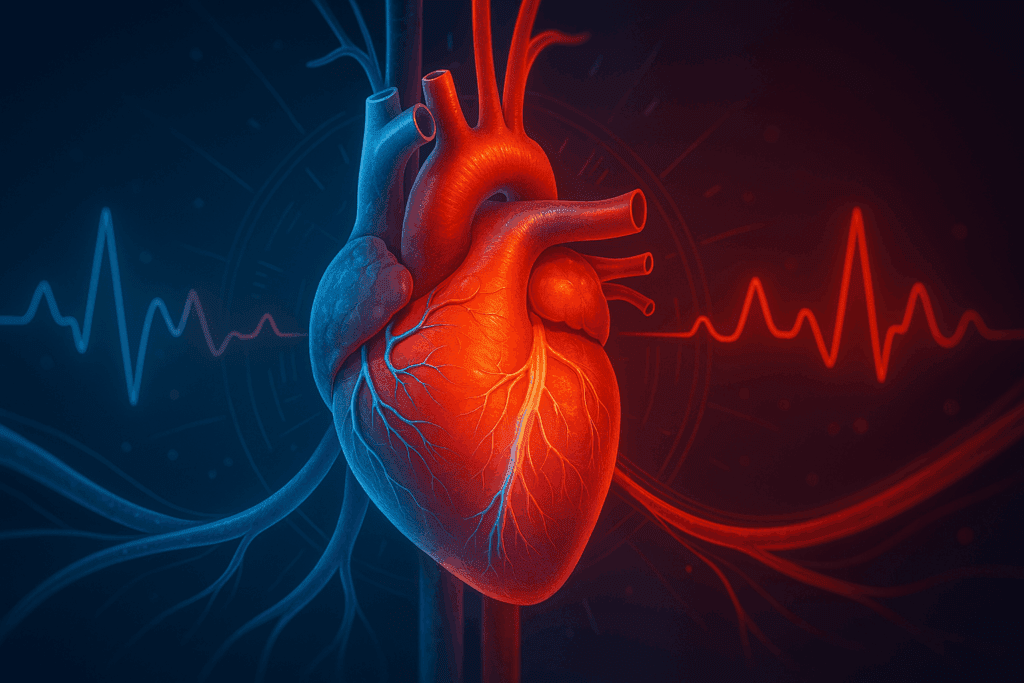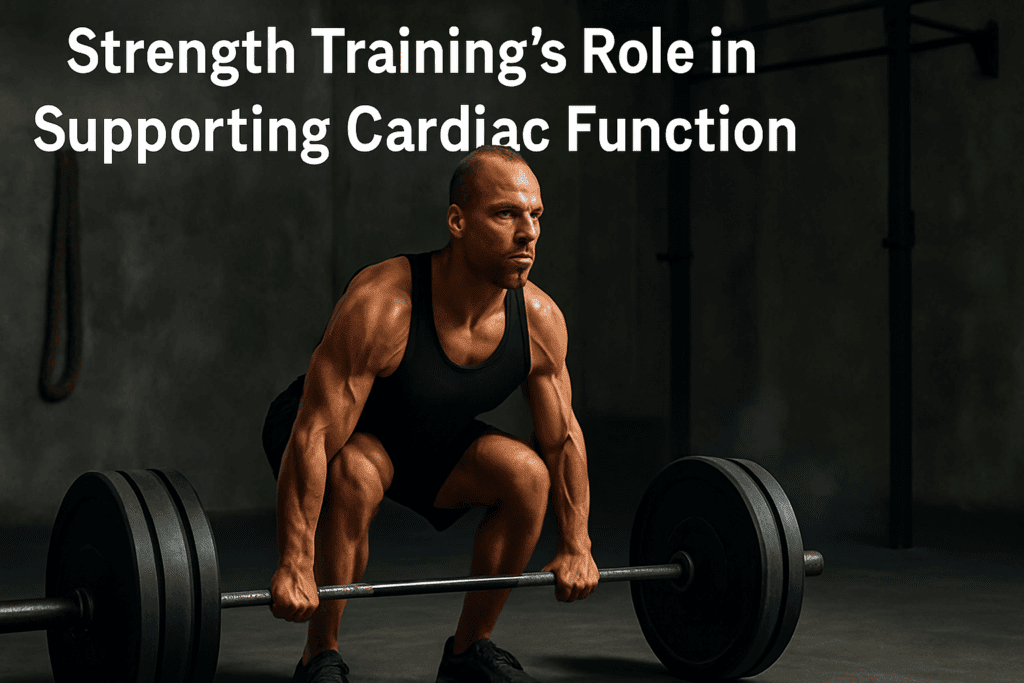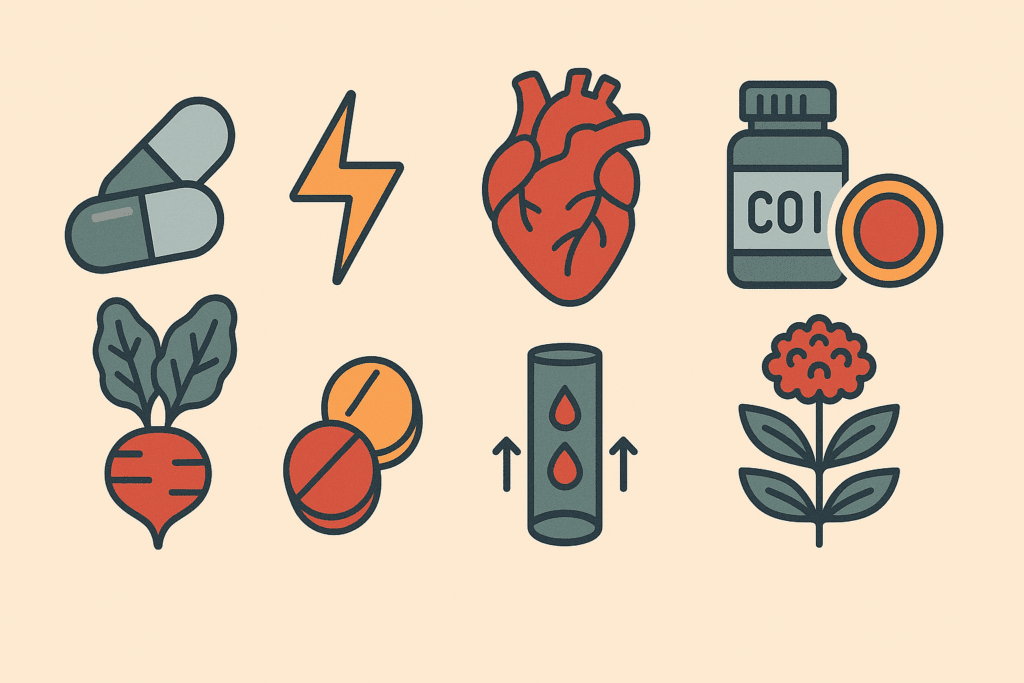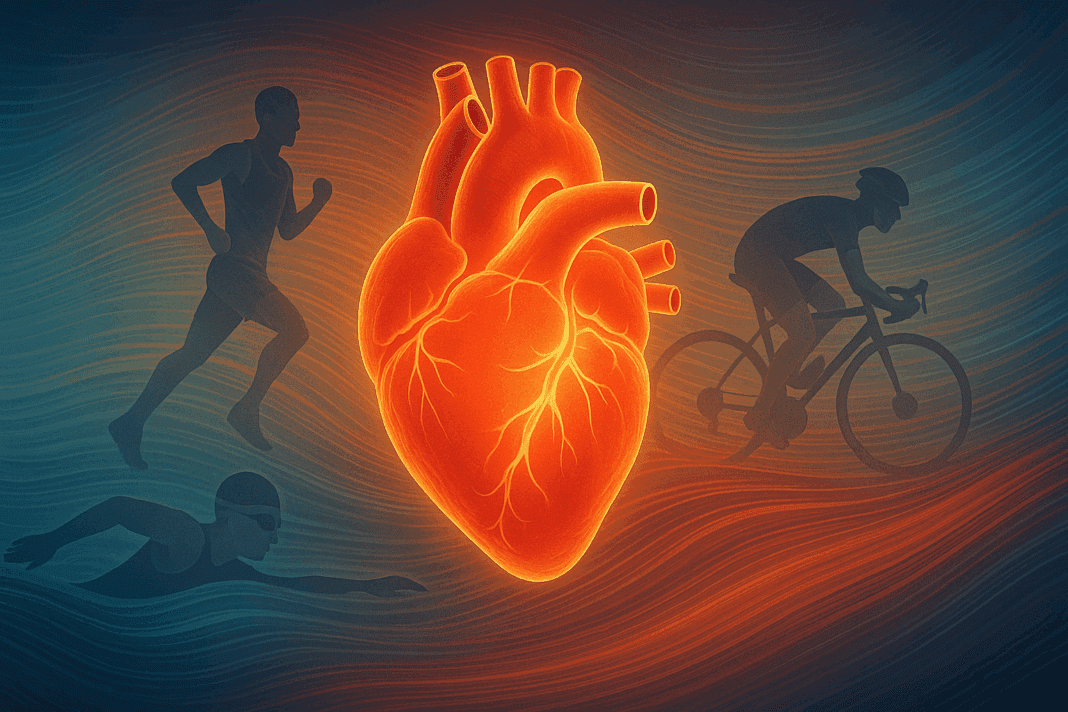Endurance athletes, fitness enthusiasts, and health-conscious individuals often seek the most effective strategies to enhance performance, stamina, and long-term cardiovascular health. At the center of this pursuit lies a crucial yet often underappreciated concept: cardiac output. Simply defined, cardiac output refers to the volume of blood the heart pumps per minute, a function influenced by heart rate and stroke volume. Understanding how to increase cardiac output through evidence-based methods is essential not only for competitive athletes but also for anyone striving to improve aerobic capacity, resilience, and total body efficiency.
The human body is remarkably adaptable, and the cardiovascular system exemplifies this plasticity. With proper training and nutritional support, the heart becomes more efficient at delivering oxygenated blood to muscles, supporting higher workloads with less fatigue. In this comprehensive guide, we explore science-backed techniques to naturally increase cardiac output, while also addressing low cardiac output symptoms and signs that may indicate a need for medical attention or a shift in one’s training strategy. Whether you’re preparing for a marathon, recovering from a cardiac event, or simply aiming to boost your fitness levels, these insights will empower you to optimize your heart’s performance safely and effectively.
You may also like: Smart Nutrition Choices for a Healthier Lifestyle: What to Know About Whole Grain Rice and Whole Wheat Rice

Understanding Cardiac Output: A Cornerstone of Endurance and Performance
To fully grasp how to increase cardiac output, one must first understand its physiological foundation. Cardiac output is calculated by multiplying heart rate (the number of beats per minute) by stroke volume (the amount of blood pumped with each beat). For example, a resting heart rate of 70 beats per minute and a stroke volume of 70 milliliters equates to a cardiac output of 4.9 liters per minute. During intense exercise, this value can increase fivefold or more to meet the metabolic demands of active muscles.
Elevated cardiac output enables efficient oxygen delivery, supports thermoregulation, and facilitates nutrient transport throughout the body. In trained individuals, increased stroke volume is typically achieved through cardiac hypertrophy, where the heart’s left ventricle enlarges and strengthens. This adaptation allows the heart to pump more blood per beat, thereby reducing resting heart rate and increasing endurance capacity. Therefore, boosting cardiac output is not merely a goal in itself; it is a fundamental driver of physical performance and cardiovascular health.
The Importance of Recognizing Low Cardiac Output Symptoms and Signs
Before diving into training and dietary strategies, it is critical to recognize the warning signs of diminished cardiac function. Low cardiac output symptoms and signs can manifest subtly at first but may progressively impair physical performance and well-being. Common indicators include persistent fatigue, lightheadedness, shortness of breath during minimal exertion, cold extremities, and rapid heart rate even at rest.
In more severe cases, low cardiac output can lead to fluid retention, swelling in the ankles or legs, and even confusion due to reduced cerebral perfusion. For athletes, a sudden decline in performance, prolonged recovery times, or unusual exercise intolerance may signal an underlying cardiovascular issue. It’s essential to differentiate between normal post-exercise fatigue and pathological symptoms that warrant further medical evaluation.
Understanding these early signs helps ensure timely intervention. Whether caused by overtraining, dehydration, underlying cardiac conditions, or nutritional deficiencies, low cardiac output can and should be addressed. Early recognition empowers individuals to adjust their lifestyle and seek appropriate care, paving the way for safe improvements in cardiac efficiency.

Cardiovascular Training: The Foundation of Increasing Cardiac Output
Among the most effective ways to increase cardiac output is through structured cardiovascular training. Aerobic exercises such as running, cycling, swimming, and rowing challenge the heart to work more efficiently. Regular engagement in moderate to high-intensity aerobic activity stimulates physiological adaptations that enhance both stroke volume and heart rate responsiveness.
Interval training, particularly high-intensity interval training (HIIT), is highly effective in pushing the limits of cardiac performance. By alternating between intense bursts of activity and recovery periods, HIIT promotes greater cardiac efficiency, mitochondrial density, and oxygen utilization. Studies show that just a few weeks of interval training can significantly elevate cardiac output, especially in previously sedentary individuals.
Long, steady-state endurance workouts also play a crucial role. While HIIT hones peak performance, steady-state training builds the aerobic base necessary for sustained efforts. Together, these modalities form a complementary system for improving cardiac output. Importantly, training should be progressive, starting with manageable volumes and intensities to avoid overtraining or injury. Consistency over time remains the key to lasting cardiovascular adaptation.

Strength Training’s Role in Supporting Cardiac Function
Though often overlooked in discussions of cardiovascular health, resistance training contributes to heart efficiency in several meaningful ways. Compound movements like squats, deadlifts, and presses require coordinated muscular engagement, promoting vascular integrity and improving blood pressure regulation. These exercises also stimulate hormonal responses that support heart muscle strength and resilience.
For individuals wondering how to increase cardiac output, incorporating strength training into their routine provides a well-rounded approach. Resistance exercise enhances venous return, thereby improving preload and subsequently stroke volume. Moreover, it reduces peripheral resistance over time, decreasing the workload on the heart during both rest and activity.
Crucially, strength training helps preserve lean muscle mass, which plays a role in overall metabolic health and insulin sensitivity. This, in turn, contributes to cardiovascular efficiency and recovery. When programmed appropriately—two to three sessions per week with adequate rest—strength training complements aerobic exercise, promoting an environment in which the heart thrives.
Breathwork and Cardiovascular Efficiency
Beyond traditional physical training, practices such as breathwork and respiratory muscle training can significantly influence cardiac output. Diaphragmatic breathing, often emphasized in yoga and mindfulness practices, promotes vagal tone and helps lower resting heart rate. This form of controlled breathing enhances parasympathetic activity, countering stress-induced sympathetic dominance that can undermine heart function.
Advanced techniques such as inspiratory muscle training (IMT) utilize resistance devices to strengthen the diaphragm and other respiratory muscles. Research has shown that IMT can increase exercise tolerance and cardiac output, particularly in populations with existing cardiovascular limitations. These practices improve ventilatory efficiency and help optimize oxygen uptake, a critical factor in endurance performance.
By integrating breath-focused exercises into one’s routine, individuals can better regulate their cardiovascular response during stress and exertion. This approach offers a non-invasive, accessible strategy for those aiming to improve heart efficiency and performance in tandem.

The Nutritional Framework for Boosting Cardiac Output
Training alone cannot fully optimize cardiac output without the support of proper nutrition. A diet rich in heart-healthy nutrients ensures that the cardiovascular system receives the building blocks it needs to function optimally. Key nutrients such as omega-3 fatty acids, magnesium, potassium, and Coenzyme Q10 play pivotal roles in maintaining heart rhythm, vascular tone, and mitochondrial energy production.
Omega-3s, found in fatty fish like salmon and mackerel, reduce inflammation and improve endothelial function. Magnesium and potassium, prevalent in leafy greens, nuts, and bananas, support electrolyte balance and reduce blood pressure, lightening the heart’s workload. CoQ10, a compound involved in cellular energy production, has shown promise in improving symptoms associated with low cardiac output, particularly in individuals with heart failure.
Equally important is ensuring adequate caloric intake and hydration. Chronic caloric deficits can lead to hormonal imbalances and impaired cardiac function, while dehydration reduces blood volume, directly lowering cardiac output. Nutritional strategies must be individualized, but the guiding principle remains the same: fuel the body to support the heart.

Managing Stress and Sleep for Optimal Heart Performance
Modern life presents no shortage of stressors, many of which directly impact cardiac health. Chronic stress activates the sympathetic nervous system, increasing heart rate and blood pressure while reducing heart rate variability—a key marker of cardiovascular resilience. Over time, this pattern can impair the heart’s ability to adapt to changing demands, ultimately affecting cardiac output.
Incorporating daily stress-reduction practices is essential for those aiming to enhance endurance. Activities such as meditation, journaling, nature walks, and social connection modulate the stress response, improving overall cardiovascular function. High performers often overlook these elements, yet their influence on heart health is profound.
Sleep, too, plays a foundational role. During deep sleep stages, the body undergoes reparative processes that influence hormonal regulation, blood pressure, and resting heart rate. Inadequate sleep not only increases the risk of cardiovascular disease but also impairs recovery from training. Optimizing sleep hygiene—maintaining a consistent sleep schedule, limiting screen time before bed, and creating a restful environment—is vital for anyone seeking to sustainably increase cardiac output.
Identifying and Addressing Low Cardiac Output in Athletic and General Populations
Despite best intentions, even well-trained individuals can experience signs of declining cardiac efficiency. Recognizing low cardiac output symptoms and signs early ensures timely adjustments to training and lifestyle. In athletes, these signs may present as unexplained performance plateaus, frequent illness, or irregular heart rhythms. In the general population, they may show up as chronic fatigue, mental fog, or reduced exercise tolerance.
Medical evaluation is crucial when these symptoms persist. Diagnostic tools such as echocardiograms, electrocardiograms (ECGs), and VO2 max testing can help identify underlying issues. Sometimes, the root cause is non-cardiac—such as anemia or thyroid dysfunction—yet still affects the heart’s performance. In other cases, early-stage heart failure or cardiomyopathies may be at play.
Addressing these issues requires a multi-pronged approach: modifying training load, optimizing nutrient intake, managing stress, and in some cases, incorporating medications or physical therapy. Importantly, this reinforces the principle that increasing cardiac output is not a linear process but one that requires ongoing monitoring, self-awareness, and adaptation.
Personalizing Strategies Based on Individual Baselines
No two individuals start from the same physiological baseline, and the path to improved cardiac output should reflect this individuality. Factors such as age, sex, fitness history, comorbid conditions, and genetic predisposition all influence how one’s heart adapts to training. What works for a 25-year-old triathlete may not be appropriate for a 60-year-old beginner aiming to walk 10,000 steps a day.
Personalization begins with assessment. Tracking resting heart rate, heart rate variability, exercise capacity, and recovery trends provides actionable insight. Wearable technology has made this process more accessible, offering real-time feedback on cardiovascular performance and recovery. These data points inform training intensity, volume, and recovery strategies.
Ultimately, the most successful approaches to increasing cardiac output are those grounded in self-awareness, guided by evidence, and adaptable over time. Working with healthcare providers, coaches, or registered dietitians can further tailor strategies, helping individuals navigate plateaus and prevent setbacks.

Integrating Recovery as a Cornerstone of Cardiac Adaptation
In the pursuit of improved performance, the importance of recovery cannot be overstated. Cardiac output improvements occur not during training itself but in the body’s response to that training. Adequate recovery ensures that the heart and vascular system repair, adapt, and strengthen between sessions. Ignoring this crucial element risks overtraining, chronic fatigue, and even regression.
Active recovery days, including light walking, stretching, or restorative yoga, support circulation without imposing excessive strain. Contrast baths, massage therapy, and foam rolling can further promote recovery by reducing inflammation and enhancing lymphatic flow. Importantly, mental rest should accompany physical recovery. Time away from structured exercise allows for cognitive restoration and emotional balance, supporting long-term motivation and heart health.
Whether one is a weekend warrior or a seasoned competitor, integrating recovery practices ensures that gains in cardiac output are sustainable. It is in this balance between effort and rest that the heart finds its true capacity for growth.

The Role of Supplementation and Functional Testing
In some cases, dietary intake alone may not meet the elevated demands of training or recovery. Supplementation, when guided by professional assessment, can bridge the gap. Key supplements with potential benefits for cardiac output include L-citrulline, beetroot juice (rich in dietary nitrates), taurine, and adaptogens like Rhodiola rosea.
L-citrulline enhances nitric oxide production, improving blood flow and reducing oxygen cost during exercise. Beetroot juice has been shown to increase time to exhaustion in endurance events, a benefit linked to improved cardiac efficiency. Taurine supports calcium handling in cardiac cells, influencing contraction strength and rhythm stability. Adaptogens help modulate the stress response, preserving heart function under physical and psychological strain.
Functional testing—such as micronutrient panels, oxidative stress markers, and metabolic profiling—can identify deficiencies or imbalances that compromise cardiovascular performance. Tailoring supplementation to these findings adds another layer of personalization to one’s performance strategy.
A Holistic Blueprint for Elevating Cardiac Output
Increasing cardiac output is not the result of a single intervention, but rather the outcome of a multidimensional lifestyle. It involves deliberate training, strategic nutrition, mindful recovery, and proactive stress management. For those experiencing low cardiac output symptoms and signs, these strategies also serve as preventative tools and therapeutic support, reinforcing the interconnected nature of cardiovascular performance and overall health.
Importantly, the path to a stronger, more efficient heart does not require perfection—only consistency and awareness. Each workout, each meal, and each restful night of sleep contribute incrementally to a more capable cardiovascular system. With guidance from science and a commitment to long-term well-being, anyone can take meaningful steps toward improving cardiac output.
Frequently Asked Questions: How to Increase Cardiac Output for Better Endurance
1. Can emotional health influence cardiac output and endurance levels?
Absolutely. Emotional well-being directly affects cardiovascular performance through the autonomic nervous system. Chronic stress, anxiety, or depression can raise cortisol and adrenaline levels, elevating heart rate while impairing stroke volume efficiency. Learning how to increase cardiac output naturally must involve strategies for mental resilience. Practices like mindfulness meditation, cognitive behavioral therapy (CBT), and even expressive writing can support emotional regulation and improve vagal tone. Addressing emotional triggers not only lowers the risk of burnout but also helps identify early low cardiac output symptoms and signs related to psychological strain.
2. Are there genetic factors that limit how much someone can improve their cardiac output?
Yes, genetic predispositions do play a role in determining the upper limits of cardiovascular capacity. For example, the size and elasticity of the heart chambers, mitochondrial efficiency, and VO2 max potential have a hereditary component. That said, learning how to increase cardiac output is still highly worthwhile even for those with less favorable genetics. Through structured training and precision nutrition, one can significantly improve their baseline, even if their ceiling is genetically determined. Additionally, personalized interventions can help manage low cardiac output symptoms and signs when genetic heart conditions like hypertrophic cardiomyopathy are present.
3. How does altitude training impact cardiac output over time?
Altitude training is a well-documented method to stimulate cardiovascular adaptation. At higher elevations, the body compensates for reduced oxygen availability by producing more red blood cells and increasing capillary density. These changes help improve oxygen transport and utilization, both of which are essential when learning how to increase cardiac output. Over time, these adaptations can translate to enhanced endurance performance at sea level. However, improper acclimatization can also trigger low cardiac output symptoms and signs, such as dizziness, fatigue, and impaired mental focus due to insufficient oxygen delivery.
4. Can hydration levels influence cardiac output during exercise?
Hydration has a profound effect on cardiovascular dynamics. Even mild dehydration decreases blood plasma volume, which in turn reduces stroke volume and total cardiac output. For those seeking to understand how to increase cardiac output, maintaining fluid balance before, during, and after exercise is essential. Electrolyte-rich fluids help maintain osmotic balance and support efficient muscle contraction and heart rhythm. Ignoring hydration can lead to early fatigue and increase the risk of experiencing low cardiac output symptoms and signs during physical activity, especially in hot or humid environments.
5. What role does iron play in supporting optimal cardiac output?
Iron is vital for oxygen transport via hemoglobin in red blood cells. When iron levels are low, the heart compensates by increasing workload to meet oxygen demands, which can eventually decrease cardiac efficiency. Athletes, particularly females and plant-based eaters, should monitor iron status as part of their strategy for how to increase cardiac output. Iron supplementation or dietary adjustments may be necessary to prevent anemia-related fatigue and low cardiac output symptoms and signs such as shortness of breath, reduced stamina, and paleness. Including iron-rich foods like lentils, spinach, and lean meats can significantly support cardiac performance.
6. Is cardiac output affected by age, and can older adults still improve it?
Cardiac output naturally declines with age due to changes in vascular stiffness, decreased heart muscle compliance, and reduced maximum heart rate. However, older adults can still meaningfully improve their cardiovascular function through consistent aerobic and resistance training. Understanding how to increase cardiac output later in life involves accounting for recovery time and focusing on low-impact modalities like swimming or walking. Nutritional support, especially with anti-inflammatory foods and sufficient protein intake, also plays a key role. Recognizing low cardiac output symptoms and signs early in aging populations—such as slower walking pace, early fatigue, or brain fog—can guide timely intervention.
7. How do beta-blockers or heart medications influence cardiac output in active individuals?
Beta-blockers and similar medications often reduce heart rate to ease the workload on the heart, which can lead to a reduction in overall cardiac output during exertion. For individuals on these medications, understanding how to increase cardiac output safely becomes more complex. Monitoring perceived exertion and working closely with a cardiologist is essential to avoid overexertion. Modifications to exercise programs are often necessary, and low cardiac output symptoms and signs such as dizziness or palpitations should be promptly reported. In some cases, switching medications or adjusting dosages may be appropriate depending on the therapeutic goals and activity levels.
8. Can chronic inflammation reduce the heart’s ability to increase cardiac output?
Yes, chronic inflammation is a significant but often overlooked factor in cardiac performance. Inflammatory markers like C-reactive protein (CRP) have been linked to endothelial dysfunction and impaired blood flow regulation. This physiological stress can make it more difficult to learn how to increase cardiac output efficiently, especially during prolonged or intense exercise. Anti-inflammatory interventions such as a Mediterranean-style diet, omega-3 supplementation, and regular low-impact activity can help counteract these effects. When inflammation goes unaddressed, it can mimic or even trigger low cardiac output symptoms and signs, including joint stiffness, sluggish circulation, and lingering fatigue.
9. Are there occupational or lifestyle patterns that commonly reduce cardiac output over time?
Sedentary lifestyles and high-stress occupations can both contribute to gradually declining cardiac efficiency. Long hours spent sitting diminish venous return, which limits preload and reduces stroke volume. Likewise, chronic exposure to job-related stress keeps the sympathetic nervous system activated, which strains heart function over time. Understanding how to increase cardiac output in this context requires lifestyle restructuring: incorporating standing desks, taking movement breaks, and practicing relaxation techniques. Individuals in high-stress roles should remain vigilant for low cardiac output symptoms and signs, such as decreased energy, lack of concentration, and poor stress tolerance.
10. What are emerging technologies that help monitor and improve cardiac output?
Several cutting-edge tools are now available to assess and enhance cardiovascular performance with precision. Wearable sensors that track real-time heart rate variability, stroke volume estimates, and VO2 kinetics provide actionable data for those interested in how to increase cardiac output. Biofeedback devices can train individuals to optimize breathing and nervous system balance, indirectly supporting cardiac function. Clinical innovations such as impedance cardiography and portable echocardiogram devices are expanding access to non-invasive cardiac monitoring. These tools are especially valuable for identifying low cardiac output symptoms and signs before they evolve into serious conditions, allowing for earlier interventions and more personalized training plans.
Conclusion: Enhancing Endurance and Performance Through Better Cardiac Output
As our understanding of cardiovascular physiology deepens, so too does our ability to train, nourish, and care for the heart in increasingly sophisticated ways. Learning how to increase cardiac output is not solely a matter of athletic achievement but a gateway to enhanced vitality, resilience, and longevity. By embracing expert-backed strategies that span training modalities, nutritional precision, breathwork, and recovery, individuals equip themselves with the tools necessary to elevate both performance and health.
For those facing low cardiac output symptoms and signs, this knowledge also provides a roadmap to reclaiming wellness and confidence. Whether you are an elite competitor or simply looking to enjoy life with more energy and less fatigue, your heart’s capacity can be nurtured and expanded. When approached mindfully and holistically, the journey to increased cardiac output becomes more than a goal—it becomes a lifelong investment in human potential.
Was this article helpful? Don’t let it stop with you. Share it right now with someone who needs to see it—whether it’s a friend, a colleague, or your whole network. And if staying ahead on this topic matters to you, subscribe to this publication for the most up-to-date information. You’ll get the latest insights delivered straight to you—no searching, no missing out.
Further Reading:
How to Improve Athletic Performance with Cardiovascular Training

